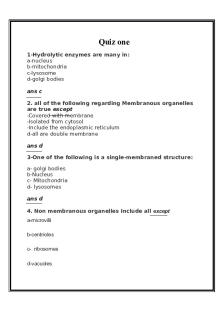CH15-3 notes for cell biology. In a pdf form PDF

| Title | CH15-3 notes for cell biology. In a pdf form |
|---|---|
| Course | Biology |
| Institution | University of Toronto |
| Pages | 7 |
| File Size | 210 KB |
| File Type | |
| Total Downloads | 50 |
| Total Views | 146 |
Summary
This shows the different course material in the the the the the t etc class and how to learn it...
Description
General Chemistry
Chapter 15: Acids and Bases
Lecture 3 of 4 $
Weak Acids continued
$
Percent ionization
$
Weak Bases -1
Recall Example (iii) from previous lecture. Find the pH of an 0.10 mol L solution of acetic acid -5
(represented as HAc) , Ka(HAc) = 1.8 10 . Rules for Approximating (vi)
-5
If K is 10 or smaller, usually always safe to ignore x, but must JUSTIFY assumption. Or if Ca /Ka > 100 then assumption usually safe.
(ii)
If in doubt, go ahead, ignore the x in (CHA - x), solve for x and if the value of x is smaller than 5% of C HA then you win. The so-called " 5 Percent Rule "
(iii)
If 5 percent rule fails you must use the quadratic!
1
Let us return to our example: -5
-1
Find the pH of an 0.10 mol L solution of acetic acid, Ka(HAc) = 1.8 x 10 . +
-
HAc(aq) + H2O(l) ⇌ H3O (aq) + Ac (aq) [initial]
0.10
-
-
[Change]
-x
+x
+x
[equilib]
0.10 - x
+x
+x
Let us do the same question again with an acid `HX' whose Ka is -3
4.0 x 10 , CHA = 0.10 mol L +
-1
1/2
Recall: [H3O ] = x = (Ka (CHA - x))
Let us ignore the x and see what happens: -3
1/2
x = (4.0 x 10 (0.10 - x))
-2
= 2.0 x 10 mol L
-1
We find that x is TOO LARGE (20% of C HA ) to ignore. We have to use the quadratic equation. 2
Percent Ionization We often compare acids and bases in terms of strong vs. weak or the pH generated when they are dissolved in water.
Another way to compare acids is to think in terms of their degree of ionization (or dissociation). Percent ionization= concentration of ionized acid/ initial concentration of acid x100
Question: How do we apply the above expression to a weak acid? HA (aq) + H2O(l) H3O+(aq)+A-(aq)
Question: How do we determine % ionization to a weak base?
+
Example: In the question at the beginning of our lecture we determined that the [H ] for the 0.10 mol -1
-3
-1
L acetic acid was 1.3 x 10 mol L . What is the % ionization?
3
Notice anything interesting about the above result?
Something else to know about % ionization :
Weak Bases Similar to weak acids, weak bases only partially dissociate in solution. Kb The equilibrium constant for the reaction of a weak base with water is reported as a __________
value.
4
There are two main types of weak bases:
(i) Ammonia and its organic derivatives +
-
NH3 (aq) + H2O ⇌ NH4 (aq) + OH (aq) +
-
CH3NH2 (aq) + H2O ⇌ CH3NH3 (aq) + OH (aq)
Other bases include (CH3)2NH, (CH3)3N, pyridine C5H5N, aniline C6H5NH2, hydroxylamine HONH2 In general: +
B + H2O(l) ⇌ BH + OH
-
(ii) Conjugate bases of Weak Acids e.g. Ac
Kb (Base)
-
Ac- + H2O ⇌ HAc + OH-
In general: A- + H2O HA +. OHB+H2O BH+ + OH-
CN- + H2O HCN + OHNH3 + H2O NH4 + OH-
5
Mathematical Treatment of W.B. We can extend the methodology for W.A. to incorporate W.B. e.g.
B
+
H2 O
⇌
BH
+
+
OH
-
i c e
As before, we can rearrange this to the convenient form:
6
-2
-1
Example For dimethylamine, (CH3)2NH, the pH of a 2.6 10 mol L solution is 11.56. What is Kb for dimethylamine?
7...
Similar Free PDFs

Cell biology lecture notes
- 108 Pages

Cell biology revision notes
- 5 Pages

Molecular cell biology Part A
- 83 Pages

Cell biology L2-12 notes
- 21 Pages

Cell biology summary notes website
- 33 Pages

Cell Biology - Lecture notes 1
- 35 Pages

Unit 1 Cell Biology - notes
- 5 Pages

Cell biology
- 3 Pages

Cell Biology Quiz CELL ORGANELLES
- 10 Pages
Popular Institutions
- Tinajero National High School - Annex
- Politeknik Caltex Riau
- Yokohama City University
- SGT University
- University of Al-Qadisiyah
- Divine Word College of Vigan
- Techniek College Rotterdam
- Universidade de Santiago
- Universiti Teknologi MARA Cawangan Johor Kampus Pasir Gudang
- Poltekkes Kemenkes Yogyakarta
- Baguio City National High School
- Colegio san marcos
- preparatoria uno
- Centro de Bachillerato Tecnológico Industrial y de Servicios No. 107
- Dalian Maritime University
- Quang Trung Secondary School
- Colegio Tecnológico en Informática
- Corporación Regional de Educación Superior
- Grupo CEDVA
- Dar Al Uloom University
- Centro de Estudios Preuniversitarios de la Universidad Nacional de Ingeniería
- 上智大学
- Aakash International School, Nuna Majara
- San Felipe Neri Catholic School
- Kang Chiao International School - New Taipei City
- Misamis Occidental National High School
- Institución Educativa Escuela Normal Juan Ladrilleros
- Kolehiyo ng Pantukan
- Batanes State College
- Instituto Continental
- Sekolah Menengah Kejuruan Kesehatan Kaltara (Tarakan)
- Colegio de La Inmaculada Concepcion - Cebu






